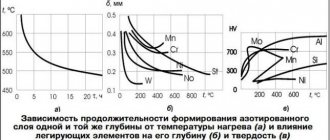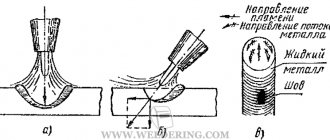Copper torch
Knowing that some metals color flames, make a copper “torch.” This is an incredibly interesting experience. Assemble the equipment shown in the figure.
Pour into a test tube several crystalliks of some copper salt, for example, CuSO4 (copper sulfate), and add denatured alcohol and a few drops of dilute hydrochloric acid to 1/3 of the height of the test tube. Seal the test tube with a stopper through which a tube passes, bent at a right angle and narrowed to end. Place the test tube in a beaker with hot water; the denatured alcohol will begin to evaporate, taking the copper salt with it. Place a burning match at the outlet of the tube: the denatured alcohol vapor will ignite and the flame will turn green-blue. The effect of the experience is extremely beautiful when observed in a dark room.
Now modify the experiment by using previously used chemical compounds that color the flame instead of copper salt. And if you have borax or boric acid, check how the boron colors the flame. Boric acid can be purchased at a pharmacy. And one more thing: do not fill the test tube more than 1/3 of the height. And under no circumstances heat the test tube with a burner!
Measuring the spectrum of a fire flame
Classic experiments were carried out - the spectra of the Sun, lasers, gas burner flames and all kinds of lamps were measured. The spectrometer passed the test and now we could begin to study the fire flames.
Examined fire flame in the fireplace
I lit a fire in the fireplace and conducted research, recording the spectrum of the flame
Let's measure the spectrum of the line of fire - that's what I called the line I saw.
Against the background of a very weak continuous black-body spectrum, two bright yellow lines were detected with wavelengths of 589.0 nm and 589.6 nm. According to the NIST database, these are sodium lines.
Spectra of a calibration lamp, fire in the fireplace, table salt and ash from the fireplace
The photograph below shows part of the spectrum of a fire flame at high magnification so that the double line of sodium 589.0 nm and 589.6 nm can be seen against the background of a continuous spectrum of incandescent carbon particles:
Close-up of spectral lines of sodium in a fire and sodium lines in ash burning in alcohol.
In further studies, the dynamics of the appearance of sodium lines in the spectrum was recorded. While the fire is burning, there are no lines in the spectrum. As coals appear and the radiation power increases, these lines appear and their brightness increases.
Colored candles
To get candles with multi-colored flames, you need to add a metal salt to the molten paraffin, which colors the flame in one color or another.
Blue candle . Paraffin can be colored blue with copper stearate. This salt is obtained by mixing solutions of copper sulfate and laundry soap. The candle flame will also be blue, thanks to copper ions.
Green candle . Green chromium(III) oxide is used as a pigment. It is obtained by the thermal decomposition of ammonium bichromate (volcano experiment). The flame color will also be green.
Yellow candle . Yellow sodium chromate will turn paraffin and candle flames yellow.
Red candle . Paraffin can be tinted with any red pigment, such as gouache. To make the flame red, you need to add some strontium or lithium salt.
Bibliography
- Krzysztof Kuszmierczyk, magazine "Horizons of technology for children" 1989-3
Potassium uses
- An alloy of potassium and sodium, liquid at room temperature, is used as a coolant in closed systems, for example, in fast neutron nuclear power plants. In addition, its liquid alloys with rubidium and cesium are widely used. The alloy of composition sodium 12%, potassium 47%, cesium 41% has a record low melting point of −78 °C.
- Potassium compounds are the most important biogenic element and are therefore used as fertilizers.
- Potassium salts are widely used in electroplating because, despite their relatively high cost, they are often more soluble than the corresponding sodium salts, and therefore provide intensive operation of electrolytes at increased current densities.
Important Connections
Purple color of potassium ions flame in burner flame
- Potassium bromide is used in medicine and as a sedative for the nervous system.
- Potassium hydroxide (caustic potash) - used in alkaline batteries and when drying gases.
- Potassium carbonate (potash) - used as fertilizer in glass making.
- Potassium chloride (sylvin, "potassium salt") - used as a fertilizer.
- Potassium nitrate (potassium nitrate) is a fertilizer, a component of black powder.
- Potassium perchlorate and chlorate (Bertholet salt) are used in the production of matches, rocket powders, lighting charges, explosives, and in electroplating.
- Potassium dichromate (chrompic) is a strong oxidizing agent, used to prepare a “chromium mixture” for washing chemical dishes and in leather processing (tanning). It is also used to purify acetylene in acetylene plants from ammonia, hydrogen sulfide and phosphine.
- Potassium permanganate is a strong oxidizing agent, used as an antiseptic in medicine and for the laboratory production of oxygen.
- Sodium potassium tartrate (Rochelle salt) as a piezoelectric.
- Potassium dihydrogen phosphate and dideuterophosphate in the form of single crystals in laser technology.
- Potassium peroxide and potassium superoxide are used for air regeneration in submarines and in insulating gas masks (absorbs carbon dioxide to release oxygen).
- Potassium fluoroborate is an important flux for soldering steels and non-ferrous metals.
- Potassium cyanide is used in electroplating (silvering, gilding), gold mining and nitrocarburizing of steel.
- Potassium, together with potassium peroxide, is used in the thermochemical decomposition of water into hydrogen and oxygen (potassium cycle "Gaz de France", France).
Biological role
Potassium is the most important biogenic element, especially in the plant world. If there is a lack of potassium in the soil, plants develop very poorly, the yield decreases, therefore about 90% of the extracted potassium salts are used as fertilizers.
Potassium in the human body
Potassium is found mostly in cells, up to 40 times more than in the intercellular space. As cells function, excess potassium leaves the cytoplasm, so to maintain concentration it must be pumped back through the sodium-potassium pump.
Potassium and sodium are functionally related to each other and perform the following functions:
- Creating conditions for the occurrence of membrane potential and muscle contractions.
- Maintaining blood osmotic concentration.
- Maintaining acid-base balance.
- Normalization of water balance.
- Ensuring membrane transport.
- Activation of various enzymes.
- Normalization of heart rhythm.
The recommended daily dose of potassium is from 600 to 1700 milligrams for children, and from 1800 to 5000 milligrams for adults. The need for potassium depends on the total body weight, physical activity, physiological state, and climate of the place of residence. Vomiting, prolonged diarrhea, profuse sweating, and the use of diuretics increase the body's need for potassium.
The main food sources are dried apricots, melon, beans, kiwi, potatoes, avocados, bananas, broccoli, liver, milk, nut butters, citrus fruits, grapes. There is a lot of potassium in fish and dairy products.
Absorption occurs in the small intestine. The absorption of potassium is facilitated by vitamin B6, and complicated by alcohol.
With a lack of potassium, hypokalemia develops. Disturbances in the functioning of the cardiac and skeletal muscles occur. Long-term potassium deficiency can cause acute neuralgia.
With an excess of potassium, hyperkalemia develops, for which the main symptom is a small intestinal ulcer. True hyperkalemia can cause cardiac arrest.
Isotopes
Electronic shell
Potassium isotopes
Natural potassium consists of three isotopes. Two of them are stable: 39K (isotopic abundance 93.258%) and 41K (6.730%). The third isotope 40K (0.0117%) is beta active with a half-life of 1.251×109 years. In each gram of natural potassium, an average of 32 40K nuclei decay per second, due to which, for example, about 4000 radioactive decays occur every second in the body of a 70 kg person. 40K is considered one of the main sources of geothermal energy released in the depths of the Earth (the power is estimated at 44 TW). Minerals containing potassium gradually accumulate 40Ar, one of the breakdown products of potassium-40, which makes it possible to measure the age of rocks; The potassium-argon method is one of the main methods of nuclear geochronology.
History and origin of the name
Potassium compounds have been used since ancient times. Thus, the production of potash (which was used as a detergent) existed already in the 11th century. The ash formed when burning straw or wood was treated with water, and the resulting solution (lye) was evaporated after filtering. The dry residue, in addition to potassium carbonate K2CO3, contained potassium sulfate K2SO4, soda and potassium chloride KCl.
On November 19, 1807, in the Baker Lecture, the English chemist Davy reported the isolation of potassium by electrolysis of molten potassium hydroxide (KOH) (in the manuscript of the lecture, Davy indicated that he discovered potassium on October 6, 1807). Davy called him "Potasy"
(lat. potasium; this name (though in some languages with two letters
s
) is still used in English, French, Spanish, Portuguese and Polish. By electrolysis of wet caustic potassium KOH on a mercury cathode, he received potassium amalgam, and after distillation of mercury is a pure metal.Daviy determined its density and studied its chemical properties, including the decomposition of water and the absorption of hydrogen.
In 1808, French chemists Gay-Lussac and L. Thénard isolated potassium chemically - by calcining KOH with coal.
In 1809, the German physicist L. W. Gilbert proposed the name “potassium” (Latin kalium, from Arabic al-kali
- potash). This name entered the German language, from there into most languages of Northern and Eastern Europe (including Russian) and “won” when choosing the symbol for this element - K.
Content
- 1 History and origin of the name
- 2 Occurrence in nature 2.1 Deposits
- 5.1 Interaction with simple substances
- 6.1 Important connections
- 7.1 Potassium in the human body
Being in nature
Due to its high chemical activity, potassium does not occur in a free state in nature. A rock-forming element, it is part of micas, feldspars, etc. Potassium is also part of the minerals sylvite KCl, sylvinite KCl NaCl, carnallite KCl MgCl2 6H2O, kainite KCl MgSO4 6H2O, and is also present in the ash of some plants in the form of carbonate K2CO3 (potash). Potassium is found in all cells (see Biological Role
). Clarke of potassium in the earth's crust is 2.4% (5th most abundant metal, 7th most abundant element in the crust). The average concentration in sea water is 380 mg/l.
Place of Birth
The largest potassium deposits are located in Canada (producer PotashCorp), Russia (PJSC Uralkali, Berezniki, Solikamsk, Perm Territory, Verkhnekamskoye potassium ore deposit), Belarus (PO Belaruskali, Soligorsk, Starobinskoye potash deposit ore).










